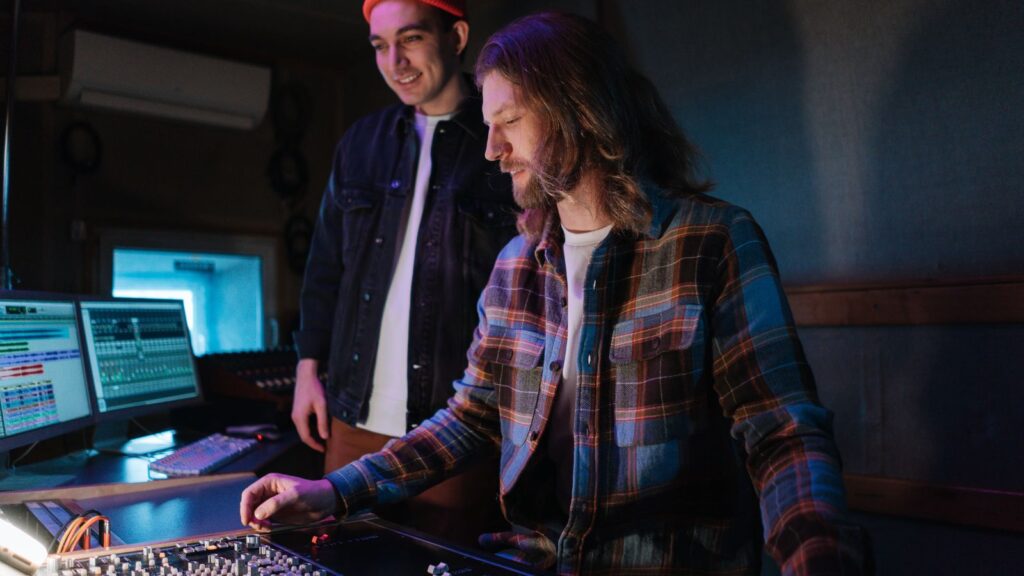In the world of sound and rhythm, there’s a hidden force that shapes our favourite tunes. It’s music production, the unsung hero behind every chart-topping hit. This creative process is like the wizard behind the curtain, transforming raw musical ideas into polished, memorable tracks.
But What is Music Production entail? Is it just about twiddling knobs and pushing buttons, or is there more to it? In this article, we’ll delve into the art and science of What is Music Production, shedding light on its intricate layers.
What is Music Production
What is Music Production, often perceived as an arcane process, shapes every song we hear. The phrase denotes the multi-stage process that transmutes melodies, lyrics, rhythms, and textures into the final music tracks that reach listeners’ ears.
Producers serve as the cornerstone in the music production process, taking on numerous roles. They guide the overall creative direction of a track, solve technical issues and have a significant sway on the final sound. Producers also liaise between various parties, namely artists, sound engineers, and record labels, ensuring these disparate forces coalesce into a harmonious whole.
The music production journey begins with pre-production. Here, demo tracks receive an initial analysis, artists and producers brainstorm ideas, and planning for recording sessions takes place. Mapping the musical piece’s trajectory in the early stages, from the tempo to the arrangement, aids in saving time while enhancing coherence during subsequent stages.
Recording or tracking follows pre-production, where artists lay their parts, either individually or collectively. Production equipment plays a pivotal role in capturing these performances, buoyed by the advent of advanced recording technologies, like digital audio workstations and high-quality microphones.
Post recording, the next phase involves mixing. Mixing engineers step in at this juncture, manipulating elements like volume, pitch, and equalisation, to ensure a balanced, pleasing sound. Segments such as vocals, instrumental sections, and the rhythm section, must be interwoven skillfully, achieving both harmony and clarity.

Key Elements in Music Production
In the realm of music production, several key factors play a considerable role. They contribute to the depth and quality of a finished piece of music. Tackling these elements skillfully, music producers ensure a cohesive and sonically appealing result.
- Musical Arrangement: Behind evergreen songs are well-thought-out musical arrangements. They dictate the structure, including verses, chorus, bridge, and ending. Producers often collaborate with artists to craft an arrangement that holds the listener’s attention, and enhances the song’s emotional impact. A Beatles’ song, “Yesterday”, is a perfect example of a well-arranged piece.
- Recording Quality: A factor often overlooked, but one that affects the final output is the quality of the original recordings. Even the best mixing and mastering engineers can’t fix a bad recording. Music producers meticulously supervise the recording session to capture the best performances and sounds.
- Sound Design and Textures: This involves choosing the right sounds for a track. From punchy drums to warm synths and textures, sound design significantly influences the sonic character of a piece of music. Daft Punk’s “Get Lucky”, for example, employs unique sound design to deliver its infectious groove.
- Mixing and Mastering: The final set of processes in music production, they assure the song’s elements gel together and sound harmonious. The “loudness” of each component and the overall track are set during mixing, with mastering providing the final layer of polish. Rihanna’s “Diamonds”, mixed by Manny Marroquin and mastered by Chris Gehringer, is a testament to the power of expert mixing and mastering.

The Importance of Music Production in the Music Industry
Music production bears significance in the music industry, as it fuels the creation of a masterpiece from an initial idea. Music producers weave stories through sound and their work moulds the listening experience of the audience.
Targeting the intricacies of music composition, a producer manipulates the structure of a song. For instance, the legendary Beatles track “Hey Jude” carries the signature of producer George Martin, whose skilled arrangement of the elements heightens its impact.
Similarly, fluctuations in recording quality can affect the listener’s perception. A high-quality recording underscores the poignant emotions in a song like Adele’s “Hello”. Conversely, a poorly recorded track distracts from the melody and lyrics’ intended message.
Critical in modern music production, sound design adds another layer of depth and complexity to a track. As sound design evolves, artists explore new sonic territories, setting trends in music genres. For example, Skrillex’s unique sound design revolutionised electronic dance music, introducing dubstep to mainstream stages.

